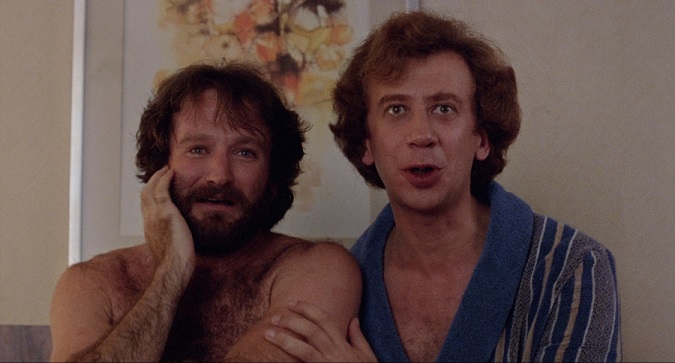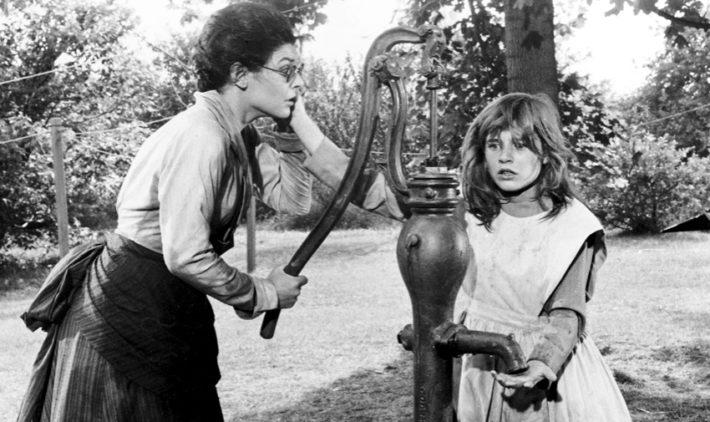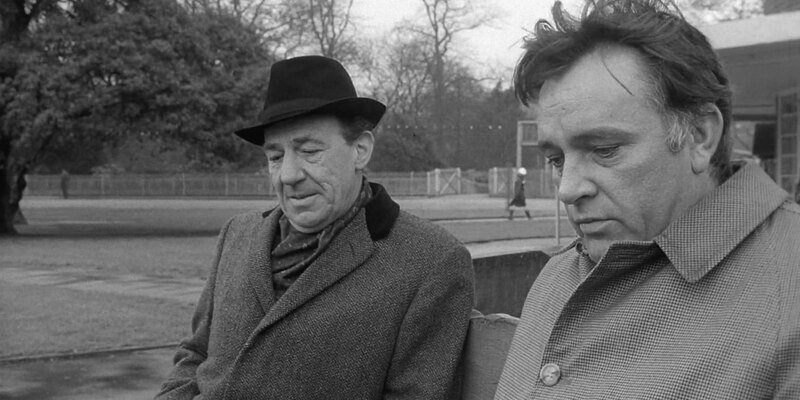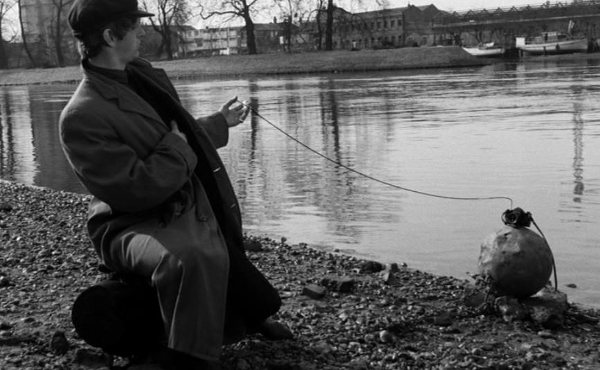By Scott Ross
Moscow on the Hudson (1984) One of Paul Mazurksy’s lesser efforts, but with compensatory charms. Despite a strong narrative core — impromptu Russian defector acclimating himself to his New York exile — and a remarkable star performance by Robin Williams, the movie is repetitive, diffuse and overlong; although only 115 minutes, it might have been far more effective at 90. The picture is, however, capped by a lovely scene in a diner, where the Russian’s bitterness at America not living up to his idealized expectations falls away on the evidence of several other immigrants’ experience. As always with Mazurksy, there is much sharp dialogue, a number of good characterizations, and some fine performances: In addition to Williams, who captures the humor, the sadness and the paranoia of his character, Maria Conchita Alonso contributes a rich performance as his Italian girlfriend; Cleavant Derricks is excellent as a Macy’s security guard who becomes the émigré‘s best friend; Aleksandr Benyaminov is endearing as his nonconformist grandfather; Tiger Haynes is warm and charming as Derricks’ own grandfather; Saveliy Kramarov is unexpectedly funny as the KGB agent who is Williams’ bête noire; and Elya Baskin, who is both manic and surprisingly moving as a would-be defector. (The movie is, in a way, Baskin’s own story.) The rich, warm cinematography is by Donald McAlpine, and David McHugh composed a charming musical score. The occasionally trenchant screenplay is by Mazursky and Leon Capetanos and the Russian sequences were shot at the Bavarian Studios in Munich.
The Miracle Worker (1962) The emotionally overpowering adaptation of William Gibson’s play, beautifully directed by Arthur Penn and marvelously acted, especially by Anne Bancroft and Patty Duke.
The Spy Who Came in from the Cold (1965) Although not David Cornwell’s first novel under the pseudonym John le Carré — he’d done two elevated whodunnits previously, which introduced his great creation George Smiley — The Spy Who Came in from the Cold was the first to catch fire. And while le Carré was far from the first fiction writer to suggest that the world of the international spy was less glamorous than grubby, its appearance in the time of the early James Bond pictures carried the unpleasant but necessary shock of realism, which the inevitable movie version did much to transport into popular art, although it did surprisingly little business. Perhaps word-of-mouth damaged it; it’s as bleak and hopeless a look at deadly Cold War games-playing by both sides as may be imagined. That’s not a criticism, but it’s hardly a selling point for mass response. Nor is Richard Burton’s performance calculated to comfort; as Leamas, the story’s anti-hero, the actor burrows into the role so thoroughly that it’s nearly impossible to separate the spy’s real character from the drunken, embittered persona he projects. The movie is never less than intelligent (the screenplay by Paul Dehn and Guy Trosper wisely follows the novel closely) and Martin Ritt’s direction, like the stark black-and-white cinematography by Oswald Morris, is virtually without flaw. The superb supporting cast includes Oskar Werner as Burton’s German interrogator, Claire Bloom as his British soul-mate, Bernard Lee as the grocer he attacks to get himself arrested, Cyril Cusack as his MI6 “Control,” Michael Hordern as an easily wounded Soviet in-between and, in smaller roles. Sam Wannamaker, George Voskovec and Robert Hardy. Only Peter van Eyck seems out of place, through overuse as a villain too easily spotted as a meanie, but Rupert Davies is the living physical embodiment of George Smiley as le Carré describes him. The only less than truthful note is the set for Burton’s behind-the-Iron Curtain trial, which is too elaborate by half. Sol Kaplan’s musical score is as stark and spare as the movie it accompanies.
Ulzana’s Raid (1972) An exceptionally well-made, often disturbing, remarkably even-handed Cavalry picture written by Alan Sharp, the Scottish iconoclast who also wrote the 1976 Arthur Penn-directed Night Moves, perhaps the greatest under-rated thriller of the 1970s. Although some of the violence is horrifying, especially during the picture’s first third, its impact is oddly mitigated by the saturated, bright rose blood, which to a modern eye looks nothing like the real thing. Sharp was at pains to distinguish his fiction from the historical fact: “The events described in the film are accurate in the sense they have factual equivalents,” he said, “but the final consideration was to present an allegory in whose enlarged features we might perceive the lineaments of our own drama, caricatured, but not falsified. The Ulzana of Ulzana’s Raid is not the Chiricahua Apache of history, whose raid was more protracted and ruthless and daring than the one I had written about. He is the expression of my idea of the Apache as the spirit of the land, the manifestation of its hostility and harshness.” Ulzana’s opposite in the movie is Ke-Ni-Tay, the Indian tracker played with extraordinary grace and gravity by Jorge Luke, who beautifully compliments the aging Army scout embodied by Burt Lancaster at his most engagingly taciturn. Robert Aldrich, whose work as a whole is seldom what one would call subtle, directed with intelligence and even sensitivity, and Frank De Vol composed an exceptional score, anchored to a spritely martial theme that would have warmed John Ford’s heart. Joseph Biroc’s stark, gorgeous images of Arizona, Colorado and Nevada are, alas, marred by some dismayingly shaky camera operation.
As the tyro lieutenant whose Christian ideals are shattered by the torture-murders of various white settlers, the young Bruce Davison reminds you once again, as he has throughout his career, that good looks and irreproachable talent are not always enough to place an actor where he deserves to be on the Hollywood totem-pole.
Yellow Submarine (1968) Although the production schedule was impossible (one year when the average for a cartoon feature was three), the budget extremely limited (as was the animation), the people behind it (George Dunning and Al Brodax) had lately been responsible for the terrible Saturday morning Beatles cartoon series and the boys, interested only in satisfying their three-picture deal with United Artists, couldn’t be bothered even to voice their own characters, the result of the effort was one of the most visually sumptuous and imaginative animated pictures ever made. Its lushness is so fulsome it’s almost overwhelming and it wears its cleverness lightly; its wit is as playful as its design. (Jeremy, the peripatetic “Nowhere Man,” is a sly dig by the screenwriter Lee Minoff at Jonathan Miller, who had directed one of his plays in New York.) I’ve never understood how a movie this visually rapturous, and featuring the songs and images of the most popular rock band in the world, made so little money at the box office in 1968 (less than $1 million at a time when the big hits routinely took in fifty) and that Fantasia was considered a “head” movie and not Yellow Submarine. The rich, glorious designs were the work of Heinz Edelmann, Jon Cramer and Dick Sawyer and the charming script was by Minoff, Brodax, Jack Mendelsohn and, before he discovered that love meant never having to say you’re sorry, Erich Segal.
Blood Work (2002) As long as the movie, directed by and starring Clint Eastwood and written by Brian Helgeland, sticks to its source, it’s a very good police-procedural laced with compassion and a certain sly wit. Alas, about two-thirds of the way in, Helgeland and Eastwood depart from Michael Connelly’s taut, intelligent novel and the whole thing collapses into who-do-you-think-you’re-kidding? absurdity and coincidence. That’s not just a shame, it didn’t help; Blood Work was one of Eastwood’s rare massive flops.
On a Clear Day You Can See Forever (1970) The Alan Jay Lerner-Burton Lane musical, sumptuously designed for the screen and cleverly directed by Vincente Minnelli, with an odd central performance by Barbra Streisand that teeters on the precipice of the obnoxious.

Buona Sera, Mrs. Campbell (1968) Another relic from my increasingly distant childhood, also (like The Miracle Worker) initially viewed in a television airing, and which photogenically is ugly as hell but which otherwise holds up remarkably well as a certain type of broad but extremely funny period sex-farce. The plot is no more relevant to life, or true to it, than a Basile fairy tale; the characters are sheerest stereotype; most of the narrative arc can be read well in advance of every point; Telly Savalas over-acts appallingly; the color photography is lackluster and doesn’t begin to take advantage of the Italian setting; the camerawork is often shaky; the rear-screen process work is sub-standard even for 1968; too many lines were badly dubbed; and the direction by Melvin Frank would barely pass muster for a contemporary Universal “Movie of the Week.” Yet the script, by Frank, the British wit Denis Norden and the “Caesar’s Hour,” “M*A*S*H” and “Dick Van Dyke Show” contributor Sheldon Keller, is often hilarious; Phil Silvers, Shelley Winters and Lee Grant contribute marvelous support; Riz Ortolani composed a delightful musical score with a breezy main theme; and, as “Mrs. Campbell,” Gina Lollobrigida at 40 is both luscious and very, very funny. Silvers in particular has one of his best movie roles: As one of three possible American fathers of Lollobrigida’s grown daughter (the others are Savalas and Peter Lawford) he takes a basic comedy shtick — turning to the camera and reacting with an increasingly flabbergasted mix of puzzlement and disbelief each time a different door is slammed in his face — and makes it riotous three times in a row. The picture is enjoyable because, while it is utter nonsense, it’s done with such good humor, and the performers have so much aplomb and are so likable; whatever the movie’s faults you can easily find yourself wishing the studios still knew how to make genuinely funny comedies even if they weren’t pretty to look at, and with comedians this damned good at making people laugh.
Remarkably, there were no fewer than two Broadway musical versions of this story, neither of whose creators admitted to stealing the plot and characters! The first, the Alan Jay Lerner-Burton Lane Carmelina of 1979, was a fast flop featuring Georgia Brown in the lead and a score woven with strands of gold; if there is, for example, a more spine-tingling expression of middle-aged erotic hopefulness than “One More Walk Around the Garden,” I don’t know it.
The second, Mama Mia!, had songs by ABBA.
Come back, Melvin Frank! All is forgiven!
A Room with a View (1985) The nearly miraculous adaptation by James Ivory, Ismael Merchant and Ruth Prawer Jhabvala of E.M. Forster’s novel.
Bloomer Girl (1956 “Producer’s Showcase” television version) Hard on the heels of the Oklahoma! revolution, E. Y. Harburg concocted a stage musical that, while comic in tone, challenged Oscar Hammerstein by taking in 19th century feminism, slavery, abolition and the Civil War and, in collaboration with Harold Arlen, offered one of the finest of 1940s musical scores. The original 1944 production also pilfered Oklahoma!‘s chief comic, Celeste Holm and, as director and musical stager, its choreographer Agnes de Mille. The 90-minute television version, filmed 12 years later, has a younger heroine in Barbara Cook and, alas, only half the score, the racier material jettisoned for live broadcast. (Although an occasional bawdy reference still sneaks through.) Although Cook is not the comedian Holm was and lacks her dry wit, she possessed one of the most sparkling lyric sopranos ever to be heard on Broadway, in 1956 a few months shy of making history in Leonard Bernstein’s Candide, and she’s charming as Evelina. (Holm could carry a tune, but only so far; Cook’s voice was just this side of the Heavenly Choir.) Keith Andes has the unenviable task of trying to make a slave-owning Southern roué palatable for a mid-20th century audience (admittedly easier in 1956 than now) but his rich baritone compensates; when he and Cook perform “Right as the Rain” together, the moment is, in spite of the primitive technology and a poor Kinescope transfer, thrilling.
Carmen Matthews is a marvelous Dolly Bloomer, warm and wry in equal measure, Paul Ford animates Evelina’s hoop-skirt manufacturing father with his robust, patented comic bluster and Roy Spearman as Andes’ runaway slave Pompey, while not the actor Dooley Wilson, the role’s originator, was, has a far better singing voice and performs a soaring version of “The Eagle and Me” that makes Wilson’s otherwise amiable performance on the Original Cast Album seem anemic. Brock Peters also shows up, as part of the trio singing “I Got a Song,” and de Mille, recreating her Civil War ballet, also brought back her principal dancers from the show: James Mitchell, Emy St. Just and Betty Low. It isn’t necessarily an ideal reading of the show — far too much of its marvelous song score was cut — but it’s a rather good introduction. The musical’s original book by Sig Herzig and Fred Saidy was adapted by Leslie Stevens and the program was briskly and imaginatively directed by Alex Segal.
The Group (1966) This adaptation by its screenwriter/producer Sidney Buchman of Mary McCarthy’s entertaining novel about eight Vassar graduates fails, as might be expected, to capture the characters’ thoughts, which make up much of the book’s content, or the author’s satirical bent. It’s also one of Sidney Lumet’s weaker pictures as a director, the shortcomings of his approach to the material exacerbated by Boris Kaufman’s uncertainty with color.
Text copyright 2021 by Scott Ross
























